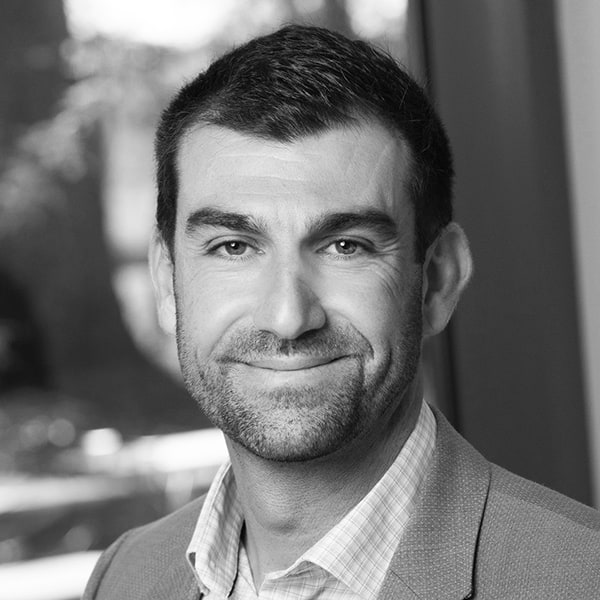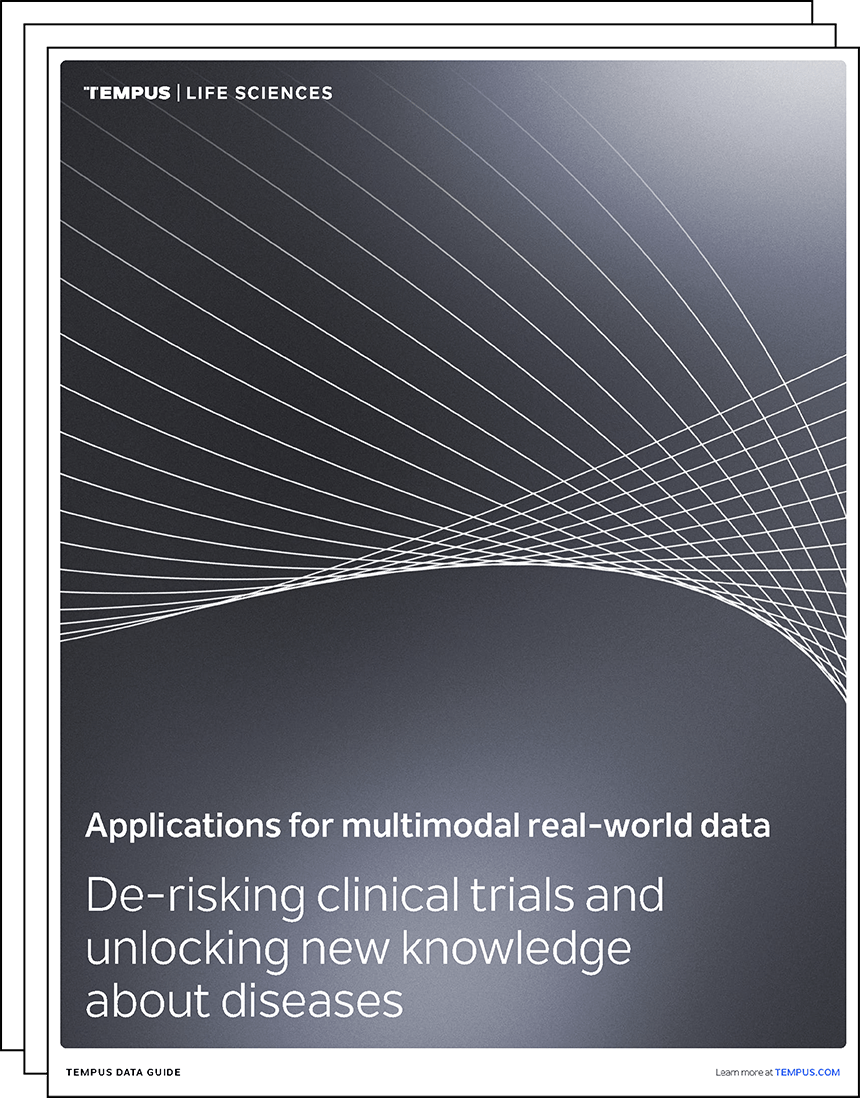-
PROVIDERS
Watch now
Are you getting the full picture? A webinar series on the power of comprehensive intelligent diagnostics
-
LIFE SCIENCES
REGISTER NOW
Closing Care Gaps with AI: The Next Competitive Edge in Pharma
Monday, July 14
9am PT, 11am CT, 12pm ET -
PATIENTS
It's About Time
View the Tempus vision.
- RESOURCES
-
ABOUT US
View Job Postings
We’re looking for people who can change the world.
- INVESTORS
09/08/2022
The promise of multimodal real-world data
In this Q&A with Dr. Hisham Hamadeh of Genmab, we explore how using multimodal RWD can help organizations solve their toughest drug development challenges.
Authors
Ryan Fukushima
COO, Tempus

Hisham Hamadeh, PhD
VP, Data Science, Genmab

COO, Tempus

Hisham Hamadeh, PhD
VP, Data Science, Genmab

Hisham Hamadeh, PhD, vice president of data science at Genmab, joined Ryan Fukushima to discuss how Genmab is using real-world data to inform biopharmaceutical innovations, from early drug discovery through late-stage drug development. Read on to learn from Dr. Hamadeh’s insights, including how he built his team, where real-world data is underutilized, and what his vision is for using real-world data to solve some of the biggest challenges in drug development.
We edited questions and responses for clarity and length.
Ryan: Dr. Hamadeh, can you describe your role at Genmab and what led you to this leadership role on the data sciences side?
Dr. Hamadeh: I lead the data science team at Genmab. My story began many years ago – before data science was even a term. At the beginning of my career, what is now the data science discipline was made up of a conglomerate of bioinformaticians, computational biologists, and quantitative analysts who had an affinity for high-density data. I believed that data would drive new insights in biology and enable us to rely less on hunches. I spent 17 years at Amgen, where I gained experience in the discovery, clinical development, and commercial aspects of the industry.
Ryan: What brought you to Genmab?
Dr. Hamadeh: Four years ago, I came to Genmab because of the caliber of the people, the exciting science, and the unbelievable agility the company has. I accepted the challenge at Genmab to enable data-driven decision making in all aspects of our business and it was reassuring to have the alignment among the executive team and the board of directors on this important point.
Ryan: How does your data science team support Genmab’s business?
Dr. Hamadeh: The data science team at Genmab works with business units and project teams in true partnership fashion where data scientists are fully embedded, understand the problem statements, and marry the right data and analytics tools with the respective problem or process to help generate insights and visuals that enable decision making. The team is under one umbrella and is organized in units that partner with discovery research, translational research, clinical development, digital health, or commercialization, which allows transferable learnings and sharing of data and code across the enterprise, where it makes sense. Gone are the days when quantitative analysts sat in a room by themselves, with colleagues making them “do their magic with the numbers.”
The data science team is a beneficiary of the relatively high degree of literacy, fluency, and educated expectations among non-quantitative colleagues at Genmab. This allows for more dynamic conversations and a quicker translation of data to insights to decision making. We’ve found these same ingredients in our partners at Tempus.
Ryan: Can you share an example of how real-world data is being underutilized in the biopharmaceutical industry today? How can biopharma organizations realize the potential of real-world data for this application?
Dr. Hamadeh: One can describe real-world data generally as a sum of past and current patient experiences that can include medical narrative, molecular data, and images. This multimodal data has the potential to influence how new targets are discovered through reverse translation, and how patients are stratified on clinical trials with the help of biomarkers. Other applications may include the use of this data in support of indication expansion or in postmarket surveillance. In all of these cases, there are certainly success stories. However, they remain the outlier cases rather than the norm or mainstream of conducting business. More progress will be made as data becomes more available, and as biopharma organizations and regulators develop increased understanding and fluency in directly transacting these data types and extracting value from them.
Ryan: When you were building Genmab’s data science team, what were some of the challenges you overcame?
Dr. Hamadeh: There are three components to our successful growth strategy:
- People: Hire people with a good understanding of the problem statements, be they biological or commercial, while also having exceptional computational chops and communication skills. This continues to take time given the demand for these relatively rare skill sets.
- Tools: Ensure that there is robust data and systems infrastructure, including cloud-based technology for storage and compute environments. With Genmab being a fast-growing company, we were fortunate to be able to build a contemporary framework more readily, since there was limited legacy infrastructure and data, which made advocating for novel approaches relatively easier.
- Partnerships and behaviors: Have partners within the organization who are comfortable with the partnership model and are appreciative of the value proposition of the data science capability. This is always earned and not taken for granted and is arguably a big differentiator for Genmab, which advocates the ONE team spirit in everything we do.
Ryan: How do you go about getting the most out of heterogeneous data sources?
Dr. Hamadeh: Heterogeneous data is underappreciated and as people have more experience in navigating the complexity of this data, more examples of utility will undoubtedly emerge. It is not trivial to integrate, analyze and display the array of data types that we currently collect on patients today including clinical, molecular, and imaging. We also have the prospect of adding data from other sources such as payers or wearable devices, or social media. Many of these data types are orthogonal and can be very complementary to paint increasingly accurate stories of the patient experience and outcomes which will help in discovering novel treatments and refining existing regimens, always guided by evidence.
The choice of data types and sources is often dependent on the question, opportunity, or end result. It is rarely a cookie cutter exercise, but rather a highly customized process based on the disease type, disease state, patient characteristics, or the type of biomarker being sought. The most important aspect of extracting the most data is to place it at the fingertips of people who need it, in a format they can readily access, and the means to apply a layer of analytics to it. Genmab is making significant progress on those fronts.
Ryan: What’s your vision for using real-world data to solve some of drug development’s biggest challenges?
Dr. Hamadeh: I can speak to the Genmab collective vision because in many ways, we act and behave as one team working in close partnership. Given the heroic effort that entails collecting real-world data, as the team at Tempus has beautifully demonstrated, one can only expect multiples in value dividends.
There are many examples of companion diagnostics that are being used to enrich patients who may benefit disproportionately from certain treatments. This is likely the tip of the iceberg as we enter the realm of blended biomarkers that rely on a diversity of non-invasive measurements and behaviors. This will undoubtedly increase the assuredness that patients need and deserve as they participate in the important decisions regarding their course of treatment.
Another thing we can do better is use real-world data to study the experience of nonresponders as well as “super responders” alike and double down on what works, while also understanding mechanisms of resistance or lack of response. Reverse translation promises to funnel all the understanding to yield a new class of treatments guided by those learnings.
With the confluence of data, algorithms and cloud computing, one cannot help but expect the application of artificial intelligence to predict durable response and outcomes based on a combination of multimodal real-world data. Encouraging evidence is starting to emerge in the literature using a combination of molecular data and computer vision and one expects more major developments in this space. This is important to enable faster and ethical decision making regarding a patient’s course of treatment in clinical trials if one can forecast the goodness of experimental regimens.
Another major area that we see much promise in is the re-imagining of how patients are matched with clinical trial opportunities using a real-world data approach. This is especially important in trials where inclusion and exclusion criteria are increasingly guided by biomarkers, which one envisions, that will only become increasingly complex and diverse.
And finally, the ability to contextualize Genmab’s phase 2 or registrational clinical trial studies in relation to real-world data is important to appreciate the congruence between the controlled experiments and what happens in the “real world.”
Ryan: Is there anything we haven’t discussed yet that you’d like to cover?
Dr. Hamadeh: Cancer patients have a hope that people out there are working to better understand their disease and to develop therapies that strive to outsmart the tumors and turn them into more manageable diseases such as diabetes and arthritis. When we use real-world data at Genmab, we don’t see numbers or images, but rather the hope of the patients and their families that their data will improve their lives in some fashion. We are grateful for the trust and continue to work with the urgency that patients expect. As we invest in more data, we strive to demonstrate the value through innovative medicines that may have a profound impact on patients’ lives. This has been the focus of our partnership with Tempus.
Learn more

Learn more
Applications for multimodal real-world data
De-risking clinical trials and unlocking new knowledge about diseases
DOWNLOAD GUIDEStay informed
Be notified whenever Tempus publishes new and relevant research, webinars, and other resources.
Sign up-
07/01/2025
Transforming R&D with Generative AI and Real-World Data
Mike Yasiejko, General Manager and Executive Vice President at Tempus, recently spoke with Andrew Mazar, PhD, Chief Operating Officer at Actuate Therapeutics, about the ways Tempus’ liquid biopsy (xF+) and methylation assays have been valuable to Actuate’s work and how the company has benefitted from the partnership
Watch now -
06/12/2025
AI & ML in action: Demonstrating real-world impact in trial design & patient care
Discover how the Tempus platform leverages AI and ML to inform standard of care practices through health equity guidelines and drive insights that help refine clinical trial design. Engage with live demonstrations showcasing how our tools identify patients by modifying inclusion/exclusion criteria and leveraging patient queries. Explore how our tools integrate NCCN guidelines and empower life science teams to access current, actionable patient-journey insights. Learn how these real-world applications can drive progress in your clinical development initiatives.
Watch replay
Secure your recording now. -
06/09/2025
Bridging the translational gap: The role of organoids in oncology R&D
This white paper explores the evolving role of organoids in oncology R&D, highlighting their potential as predictive preclinical models and their ability to reduce translational risk. Download for a comprehensive overview of the scientific landscape, key adoption barriers, emerging innovations, and how pharma companies leverage organoids to accelerate precision medicine.
Read more


